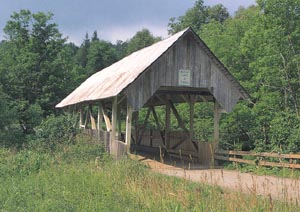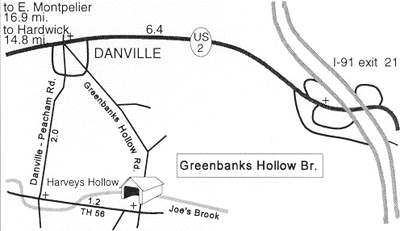danville
Back to Archive.
Danville's Bridge Selected for Renovation Update
Ghostly in its coat of white paint, the seventy-four-foot Greenbanks Hollow Bridge crosses Joe's Brook just upstream of a broken dam. Stone foundations stand dark in the brush along the banks of the stream. The bridge features a queenpost truss and a wide flaring roof much like the spans in the neighboring town of Lyndon. A bronze plaque mounted on a stone by the bridge portal reads: "Historic Site Greenbanks Hollow Covered Bridge 1886 Danville."
 Built by craftsmen whose
names are lost to us, Greenbanks Hollow Bridge crosses Joe's Brook just upstream of a ruined
dam. Ghostlike in low light, this white-painted span sparkles in the sun.→
Built by craftsmen whose
names are lost to us, Greenbanks Hollow Bridge crosses Joe's Brook just upstream of a ruined
dam. Ghostlike in low light, this white-painted span sparkles in the sun.→A bridge built here in the early 1800s burned in 1885 and was rebuilt in 1886. H. W Congdon in The Covered Bridge believes the original bridge was built without a roof.
In 1970 the bridge roadway was reinforced with steel beams installed on the deck and tie-bolted to the bottom chords below. The structure has also been supported with piers.
The Vermont Agency of Transportation has recommended that the town consider two options: close or relocate the bridge to a preservation site and build a new structure or reconstruct the bridge for moderate traffic. The Miller's Run Bridge in Lyndon offers an example of such reconstruction.
The bridge is best reached by driving south from Route 2 through Danville on the Danville-Peacham road for two miles. Turn left at Harvey's Hollow onto town highway 56 and drive east one mile to the bridge. Once you leave Harvey's Hollow, the roads are unpaved, and travel during mud season can be chancy.
To return to Route 2, you have the option of crossing the bridge and driving north, back to Danville.
*Adapted from Spanning Time: Vermont's Covered Bridges.
Chartered in 1786, Danville was named for the French Admiral Le Duc D'Anville. During
their struggle to form a state in the New Hampshire Grants; the efforts of Ethan Allen and his
associates were encouraged by the French Consul at Boston. In appreciation, they named several
townships in honor of distinguished Frenchmen.

Like all of the towns chartered and settled in those early years, the economy was based on water power and agriculture. Population centers began where industry could grow, which in Danville was along Joe's Brook. Today, there is very little evidence of those beginnings except for the covered bridge and the remains of the old mill works, the villages are gone.
During the Revolutionary War, Captain Joe fought against the English, hating them for having dispersed his people in Nova Scotia. He and Molly had the distinction of having dined at the table of General George Washington. After the war they settled in Danville on a pension granted by the State of Vermont.
Today, Joe's Pond has the additional distinction of serving as the area harbinger of spring. Each year a cement block is set on the ice and the Spring season can't begin until the ice melts enough to let the block sink. Each year a Joe's Pond spring pool is set up and participants purchase blocks of time. Happy is the winner when the block sinks at the hoped-for day, hour, and minute.

The town of Danville has been slated to receive a $300,000 grant to repair the Greenbanks
Hollow Covered Bridge. The grant was approved by the U.S. Department of Transportation
under the National Covered Bridge Preservation Act. The act, authored by Senator Jim Jeffords,
provides 80 percent federal funding for historic bridge reconstruction and research.
The Danville bridge is one of two
Vermont bridges selected for the preservation grants this year; the other is the Sanderson Bridge
in Brandon. Last year it was Thetford's Union Village Bridge and Cambridge's Poland
Bridge.
The trusses that once supported the old
Greenbanks Covered Bridge are to be reconstructed allowing the removal of a pier and a pair of
steel girders that have provided temporary bracing for the old span since they were installed back
in the 1970s. In addition, the deck system and the roof will be replaced.
The bridge was inspected in October of
1994 as part of a state-wide study of Town owned covered bridges sponsored by the Vermont
Agency of Transportation. The inspectors recommended that the community close the bridge to
traffic and construct an adjacent bypass, or replace the bridge and move it to a nearby
preservation site. The cost to replace the bridge was estimated at the time to be $315,000.
Thursday, April 26 - Steve White, Administrative Assistant for the Town of Danville
has been tracking progress in the effort to get work started to preserve the Greenbanks Hollow
Covered Bridge under the National Covered Bridge Preservation Act.
"I got a call from a David Hoyne," said
White. "I had called in to be sure that the town did not lose Jeffords' grant money . . . they had to
have the plan put together by September 30th of this year, so they are trying to fast track this
thing, they've jumped right on it."
The engineering consulting firm Hoyle,
Tanner Associates of Manchester, NH has been authorized by VTrans to study the bridge.
"They've got them on line as consulting engineers," White said. "And we (The Town of Danville)
are working right now with some easement issues. The Selectboard has given the OK to close
traffic on the road during construction and to utilize the three rod right-of-way."
Project Manager Susan Scribner said
that a meeting will be scheduled in two to three months, said White, when she has heard from
Hoyle, Tanner and plans for the work can be completed. "They are looking for a 2002
construction season which is one summer away."
 Joe Nelson, P.O Box 267, Jericho, VT 05465-0267, jcnelson@together.net
Joe Nelson, P.O Box 267, Jericho, VT 05465-0267, jcnelson@together.netNo part of this web site may be reproduced without the written permission of Joseph C.
Nelson
Photo and Drawing, Copyright © 2001, Joseph C. Nelson
This file posted May 4, 2001